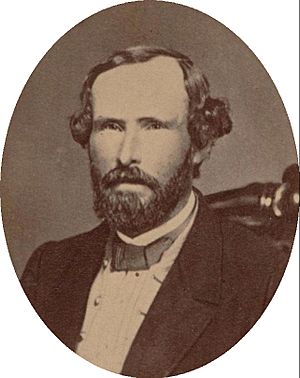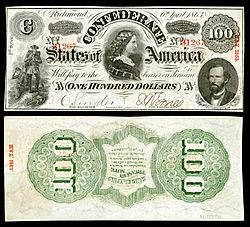George W. Randolph facts for kids
Quick facts for kids
George Randolph
|
|
|---|---|

Published circa 1866
|
|
| 3rd Confederate States Secretary of War | |
| In office March 24, 1862 – November 15, 1862 |
|
| President | Jefferson Davis |
| Preceded by | Judah Benjamin |
| Succeeded by | James Seddon |
| Member of the Virginia Senate from the Richmond district |
|
| In office 1863 – March 15, 1865 |
|
| Preceded by | John Robertson |
| Succeeded by | Charles Campbell |
| Personal details | |
| Born | March 10, 1818 Albemarle County, Virginia, U.S. |
| Died | April 3, 1867 (aged 49) Charlottesville, Virginia, U.S. |
| Political party | Democratic |
| Spouse | Mary Elizabeth Adams |
| Parents | Thomas Mann Randolph Jr. Martha Jefferson Randolph |
| Relatives | Thomas Jefferson Randolph (brother) |
| Alma mater | University of Virginia |
| Military service | |
| Allegiance | |
| Branch/service | |
| Years of service | 1831–1839 (USA) 1861–1865 (CSA) |
| Rank | Midshipman (USN) Major (Virginia Militia) Brigadier General (CSA) |
| Battles/wars | American Civil War Battle of Big Bethel |
George Wythe Randolph (born March 10, 1818 – died April 3, 1867) was an important figure in Virginia during the American Civil War. He was a lawyer, a planter, and a politician. He also served as a general in the Confederate Army.
In 1861, Randolph represented the city of Richmond at the Virginia Secession Convention. For eight months in 1862, he was the Confederate States Secretary of War. After that, he served in the Virginia Senate, representing Richmond until the war ended.
Contents
Early Life and Family Connections
George Wythe Randolph was born in 1818 at Monticello, near Charlottesville, Virginia. His mother was Martha Jefferson Randolph, who was the daughter of U.S. President Thomas Jefferson. His father was Thomas Mann Randolph Jr., who later became the governor of Virginia.
George was the youngest son of his parents. His family had deep roots in Virginia and was connected to many important early families. He was named after George Wythe, a signer of the United States Declaration of Independence. Wythe was also a law professor to Thomas Jefferson and a judge who was against slavery.
George Randolph received a private education. He also attended schools in Cambridge, Massachusetts, and Washington, D.C. His mother sent him away to help him avoid family problems and Virginia politics. His father had many debts, and the family lost their plantation, Edgehill, in 1826. However, George's older brother, Thomas Jefferson Randolph, managed to buy it back.
From 1831 to 1839, George served as a midshipman in the United States Navy. He sailed on ships like the USS John Adams and USS Constitution in the Mediterranean Sea. He also trained at the Naval School in Norfolk, Virginia. In 1837, while still in the Navy, he began studying at the University of Virginia. He might have been recovering from tuberculosis, a lung disease, which he caught during his travels. This illness would affect him for many years.
After his naval service, Randolph studied law with an experienced lawyer. He was likely guided by George Tucker, a professor at the University of Virginia.
Marriage and Family Life
On April 10, 1852, George W. Randolph married Mary Elizabeth (Adams) Pope. She was a young widow. They did not have any children together. Mary Randolph later became involved in the Richmond Ladies Association. This group helped organize support and aid for the Confederate war effort.
Views on Slavery
Some members of the Randolph family, like George Wythe, were against slavery. They sometimes freed enslaved people during their lives or in their wills. After Nat Turner's Rebellion, George's brother, Thomas Jefferson Randolph, tried to pass a law for gradual emancipation in Virginia. However, the plan was defeated. In 1860, George Wythe Randolph owned one enslaved person, an elderly woman. Like other large farms in Virginia, the family's Edgehill plantation also used enslaved labor.
Public Service and Military Career
After becoming a lawyer in 1840, Randolph practiced law in Charlottesville, Virginia. He and his wife lived at the family's Edgehill plantation. Between 1849 and 1851, they moved to Richmond, the state capital. Randolph became very active in the community. He started the Richmond Mechanics' Institute and was an officer in the Virginia Historical Society.
Forming the Richmond Howitzers
After John Brown's raid at Harper's Ferry, there were fears that abolitionists might try to free him from jail. In response, Randolph helped organize the Richmond Howitzers. This group was part of the troops sent by Virginia Governor Henry A. Wise to secure the town. When they returned, they received naval howitzers, which are a type of cannon, and this gave their unit its name. They first paraded in Richmond on July 4, 1860.
As Southern states began leaving the Union after Abraham Lincoln was elected president, the United States became divided. Richmond voters chose Randolph and two other lawyers to represent them at the Virginia Secession Convention of 1861. Randolph spoke in favor of Virginia leaving the Union.
Randolph was part of a special group that met with President Lincoln in Washington, D.C., on April 12, 1861. This was the same day that Confederate forces fired on Fort Sumter. The group found President Lincoln determined to keep Federal forts in the South. On April 18, the day after Lincoln asked for volunteers to put down the rebellion, the Convention voted to secede. This decision was then sent to voters for approval.
Military Leadership During the War
On April 21, Governor Wise called the Richmond Howitzers into state service. They were sent to stop a Union ship, the USS Pawnee, which was thought to be heading to shell Richmond. Randolph became a major and took command of the Richmond Howitzers on May 1, 1861.
His troops were involved in early actions of the war. On May 7, some of his men fired on the USS Yankee, which was the first hostile shot fired in Virginia during the conflict. On June 10, Randolph's Howitzers fought in the Battle of Big Bethel near Yorktown. This was their only battle as a battalion during the war. Randolph also designed defenses to protect Yorktown and the Hampton Roads area. These defenses were important in stopping Union General George McClellan's campaign the next spring.
In September 1861, Randolph was promoted to colonel. Then, on February 12, 1862, he became a brigadier general.
Secretary of War
Confederate President Jefferson Davis appointed Randolph as Secretary of War on March 18, 1862. He started the job on March 24, 1862. As Secretary of War, Randolph worked to improve the department. He made changes to how supplies were obtained and helped create a law for drafting soldiers. He also worked to strengthen the Confederacy's defenses in the west and south.
However, Randolph often disagreed with President Jefferson Davis. He also faced a debate about using hidden explosive shells. Union troops found these shells after capturing Yorktown. Randolph argued that such devices were not allowed by the rules of war, but could be used if left on a fort's wall to prevent capture or allow defenders to retreat safely. Due to his worsening health from tuberculosis, he resigned on November 17, 1862.
Even with his health issues, Randolph was elected as Richmond's state senator. He served in the Virginia Senate for the rest of the war.
Later Life and Legacy
In 1864, Randolph and his family traveled to Europe, avoiding the U.S. naval blockade. He received medical treatment in England and southern France. In April 1866, he took an oath of loyalty to the United States in France. The Randolphs then returned to Virginia.
George Wythe Randolph died from tuberculosis on April 3, 1867, at Edgehill. He is buried at Monticello in the Jefferson family graveyard.
Honors
- George W. Randolph was featured on the $100 bill printed by the Confederate States of America.


